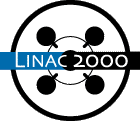
J. D. GILPATRICK, D. BARR, D. BRUHN, L. DAY, J. LEDFORD , M. PIECK, R. SHURTER, M. STETTLER, R. VALDIVIEZ (LANL), J. KAMPERSCHROER, D. MARTINEZ (GENERAL ATOMICS), J. O'HARA, M. GRUCHALLA, HONEYWELL, D. MADSEN, ARES CORPORATION,
A 52-magnet lattice is presently being installed in the Low Energy Demonstration Accelerator (LEDA) facility between the radio frequency quadrupole (RFQ) and the simple LEDA high-energy beam transport (HEBT). The purpose of this FODO-lattice beam transport is to provide a beam line apparatus to measure the formation of beam halo and compare the measured data with halo simulations. To attain this measurement goal, several types of beam diagnostics instrumentation are being installed in the magnet lattice. The instrumentation suite includes nine beam profile measurement stations capable of detecting the beam distribution charge past 0.01% of the distribution peak. These profile measurement stations each use a slow wire scanner to detect the distribution core, a graphite/copper scraper that detects the 'tails' of the distribution, and a separate prompt gamma loss measurement that detects that the 'tail' particles are protons with energies greater than approximately 4-MeV. Included also in the instrumentation suite are five pairs of beam position monitors, four scintillator/photomultiplier tube loss monitors, three pulsed-current measurements, and a time-of-flight energy measurement. This paper will describe each of these measurements, initial test data, and how they are expected to perform.
* This work is supported by the U. S. Department of Energy.
Comments or Questions to
linac2000@slac.stanford.edu